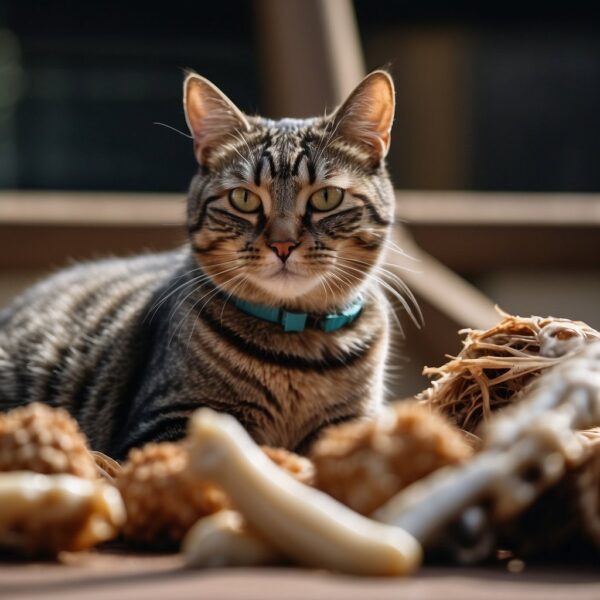
Cats Eating Chicken Bones: The Risks
When it comes to feeding cats, parents wonder if their cat can eat chicken bones. And wonder about the safety of chicken bones. It’s a common question because chicken is a staple protein source for humans, and sharing with our feline friends seems natural. However, caution is advised. While cats in the wild may consume bones as part of their diet, domestic cats may face risks from processed chicken bones. The cooking process alters the structure of the bones, making them brittle and prone to splintering. Splintered bones can cause choking or damage the digestive tract, posing serious health risks to cats.
Raw chicken bones are typically softer and less likely to splinter, so they have been considered safer for cats to eat in terms of physical structure. They can also provide nutritional benefits, such as calcium. Nevertheless, there are still risks, such as the potential for blockages or tears in the gastrointestinal system, and the danger of bacterial contamination. This underscores the importance of adhering to safe feeding practices, including consulting with a veterinarian before changing a cat’s diet. Recognizing complications early and understanding the role chicken bones play in a balanced feline diet are crucial for maintaining a cat’s overall health.
Key Takeaways
- Domestic cats may face risks from splintered chicken bones, especially if the bones are cooked.
- While raw chicken bones are softer, they still pose health risks and require caution.
- Cat parents should consult with a vet before introducing bones into their cat’s diet.
Risks Associated with Chicken Bones for Cats
While some cat parents may consider giving chicken bones to their cats as a treat, it is important to be aware of the potential risks they pose to feline health. Chicken bones can lead to serious complications, including choking, internal injuries, and bacterial infections.
Choking Hazards and Intestinal Obstruction
Chicken bones can create immediate health emergencies for cats. The bones are often small enough to be ingested but can become lodged in the throat or intestines, leading to choking or intestinal obstruction. Symptoms of blockage or obstruction might include visible discomfort, vomiting, or a sudden lack of appetite. If not promptly addressed, such occurrences may require urgent veterinary intervention and could even lead to hospitalization.
The Danger of Cooked Chicken Bones
Unlike raw bones, cooked chicken bones are far more dangerous for cats because they are brittle and can splinter easily. This can cause internal injuries such as tears or perforations in the gastrointestinal tract. Specifically, wing bones and drumsticks pose significant threats due to their size and shape, which increase the likelihood of causing an airway blockage or internal injuries.
Bacterial Infections from Chicken Bones
Raw chicken bones carry the risk of bacterial infections such as Salmonella, Campylobacter, and E. coli. Cats consuming contaminated chicken bones may suffer from a bacterial infection that can lead to serious illness. It’s vital for cat parents to be aware of the symptoms of these infections, which typically include vomiting and diarrhea, and to seek veterinary care promptly if they suspect their cat might be infected.
Nutritional Considerations: Chicken Bones for Cats
Chicken bones can be a source of nutrition in a cat’s diet, yet it is critical to distinguish between raw and cooked bones, as well as to understand their proper role and potential benefits.
The Role of chicken Bones in a Cat’s Diet
Bones have historically played a part in the diets of wild cats. They are a source of minerals such as calcium, phosphorus, magnesium, potassium, and iron. These minerals support the overall maintenance of many bodily functions. In a domestic setting, a balanced diet typically includes commercially prepared foods that meet a cat’s dietary requirements, including animal protein, vitamins, and minerals. Raw bones may complement this diet, but should not replace it, as they do not provide a complete nutritional profile on their own.
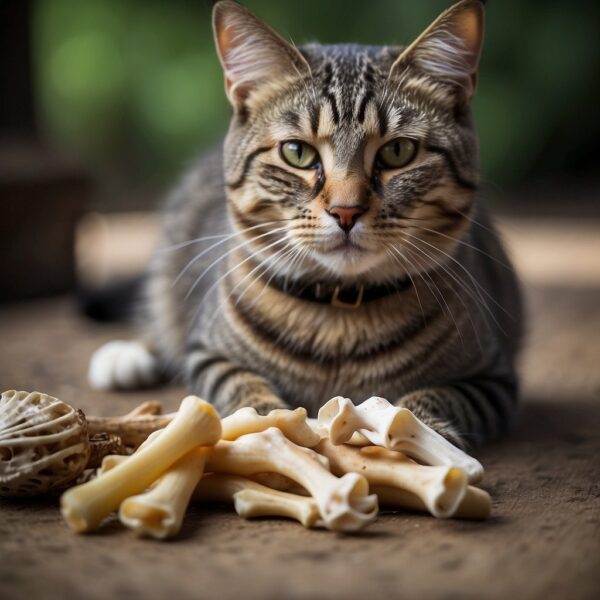
Safe Feeding Practices for Cats and Chicken Bones
When considering offering chicken bones to cats, guardians must prioritize safety to meet the dietary needs for optimal health. Chicken bones must be introduced cautiously, and alternatives like bone broth could provide a safer nutrient source.
Bone Broth: A Safer Alternative
Homemade bone broth offers a safer alternative for cat parents who want to enrich their cats’ diet with the benefits of bones without the risks. Bone broth is rich in nutrients and can:
- Provide essential minerals in a form that’s easy for cats to absorb.
- Serve as a hydrating treat that supports joint health and can soothe the digestive tract.
To prepare homemade bone broth for cats, pet owners should:
- Select raw bones from poultry.
- Simmer the bones in water for an extended period, typically 24 hours, to extract the nutrients.
- Strain the broth to remove all bone fragments before offering it to the cat.
The final product should be free of onions, garlic, and excessive seasoning, which can be harmful to cats. Bone broth can be given directly or added to their regular food to enhance moisture and flavor.
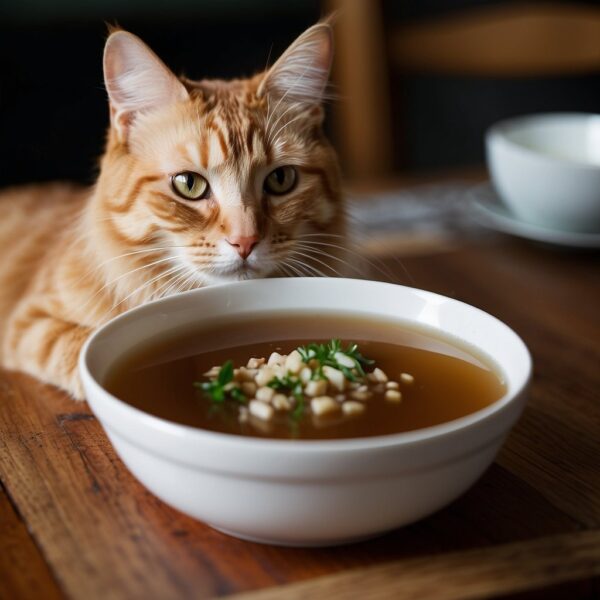
Complications from Chicken Bones in Cats
Cats may encounter several health issues after ingesting chicken bones, such as choking or gastrointestinal problems. It is imperative to recognize the symptoms promptly to provide necessary care.
Identifying Symptoms of Bone Ingestion Issues
When a cat has consumed chicken bones, several complications may arise that require immediate attention. Symptoms can range from discomfort to life-threatening conditions.
- Choking Hazard: If a cat attempts to swallow bone fragments, they can become lodged in the throat, leading to choking. Indications of choking include difficulty breathing, pawing at the mouth, panic, and a blue-tinged tongue. Immediate veterinarian intervention is necessary.
- Gastrointestinal Obstruction: Bones can cause partial or complete obstructions in the gastrointestinal tract. Symptoms include vomiting, lethargy, a lack of appetite, and visible discomfort. If an obstruction is suspected, a veterinarian may need to perform surgery to remove the bones.
- Digestive Distress: Even if bones pass through the esophagus, they can still cause irritation or injury further along in the digestive system. Signs to watch for include changes in bowel movements, such as constipation or stools with blood, and persistent vomiting.
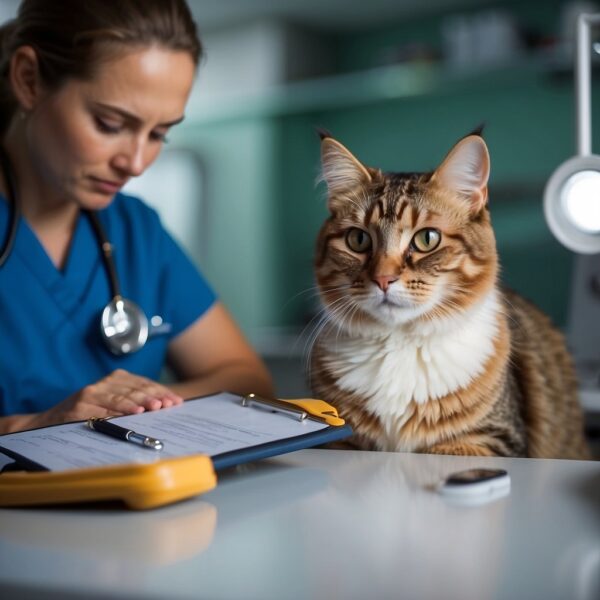
Considerations for a Cat’s Overall Diet and Health
When incorporating chicken bones into a feline diet, safety and nutritional balance are paramount. Both the physical health of cats and the quality of their diet must be addressed to ensure a harmonious integration of chicken bones, if they are to be included at all.
Balancing Cat Diets with Safe Bone Alternatives
Cats, as obligate carnivores, require a high-protein diet which meat naturally provides. However, chicken bones can pose serious risks to cats, including choking, intestinal blockage, or splinters causing internal damage. To support dental health and provide nutritional benefits, safe bone alternatives such as commercially available dental treats can be considered, keeping in mind size appropriateness for the cat’s jaws and teeth. These alternatives should be free from preservatives and toxic ingredients that could harm the cat’s digestion and overall well-being.
- Safe Bone Alternatives:
- Dental chews
- Chew toys designed for dental health
The Importance of Professional Veterinary Advice
Before making any significant changes to a cat’s diet, including the introduction of bones or bone alternatives, consulting with a veterinarian is essential. They provide tailored advice based on individual health statuses, like the condition of the teeth, jaw, and GI tract. A vet can also help determine the appropriate portion sizes and frequency for serving these items to avoid obesity and malnutrition, ensuring a balanced diet that considers all dietary requirements for optimal health and happiness. Cats rely heavily on their sense of smell; thus, changes in their diet should also be appealing to promote a positive feeding experience.
- Consult Your Veterinarian About:
- Cat’s specific dietary needs
- Portion sizes and frequency
- Risks of bone inclusion in the diet
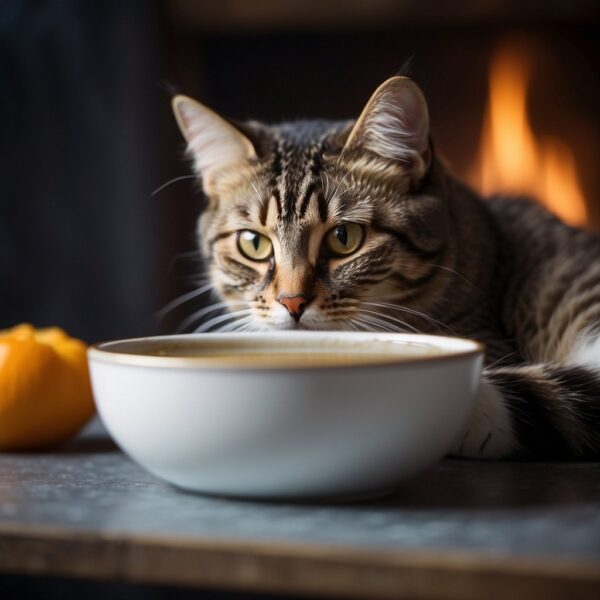
Cats and Chicken Bones: Frequently Asked Questions
When it comes to cats and chicken bones, cat guardians often have concerns about safety and health implications. This section addresses some of the most common inquiries.
What are the symptoms of a cat eating chicken bones?
If a cat consumes chicken bones, they may exhibit symptoms such as gagging, drooling, pawing at the mouth, or difficulty swallowing. In more severe cases, vomiting or a lack of appetite could indicate intestinal blockage.
What steps should I take if my cat ingests cooked chicken bones?
If a cat ingests cooked chicken bones, it’s crucial to monitor them closely and contact a veterinarian promptly. Cooked bones can splinter and cause internal injury, so professional assessment is necessary.
Are raw chicken bones safe for cats to consume?
Raw chicken bones, while less prone to splintering than cooked bones, still pose a choking hazard and risk for intestinal blockage or injury. It’s advisable to consult with a veterinarian before offering raw bones to ensure they are appropriate for your cat.
Is it safe for cats to eat chicken wing bones?
Chicken wing bones, especially if cooked, can splinter and pose a significant threat to a cat’s health. They should be avoided to prevent the risk of choking, obstruction, or injury to the digestive tract.
What types of bones can cats safely eat?
Cats may safely eat certain types of bones that are raw and properly sized to prevent choking or obstruction. A veterinarian can suggest appropriate options and provide guidance on safe bone consumption for cats.
How do cats’ digestive systems handle bone consumption?
Cats’ digestive systems can process small, raw bones that are an appropriate size. Caution is advised because bones can be hard on the teeth and potentially cause obstructions or internal damage if not properly chewed.